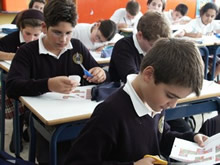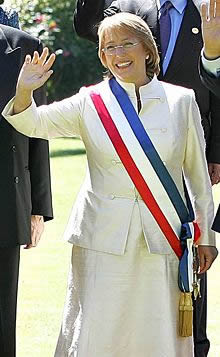| Home > Chile |
CHILE:
Country Profile of Chile
Chile, is a country in South America occupying a long and narrow coastal strip wedged between the Andes mountains and the Pacific Ocean. The Pacific forms the country's entire western border, with Peru to the north, Bolivia to the northeast, Argentina to the east, and the Drake Passage at the country's southernmost tip.
|
☻Capital: - Santiago ☻Area: - Total: 756,950 kmē (38th) 292,183 sq mi - Water (%): 1.07 ☻Independence: from Spain - First Nat. Gov. Junta: September 18, 1810 - Declared: February 12, 1818 - Recognised: April 25, 1844 |
☻Official languages: |
Geography of Chile:
 When one looks at a map of South America, the country of Chile usually stands out for its long, thin strip stretching down the west of the continent. This slender country extends down the southwestern coast of South America for over 2,700 miles. At the same time though, its width does not exceed 150 miles at any point. For this, the countryīs length is 18 times any given point of its width. The shape of Chile came about during the Spanish settlement. The settlers landed on the western side of the Andes, towards the central part of the country. Two of the largest peaks in the Americas are located in this region, Aconcagua and Nevado Ojos del Salado. These mountains are a huge barrier where passes carry through to the Argentinien side. For this reason, Chile could only grow towards the north and the south beyond itīs colonial territory. It is these mountain ranges in Chile are what make this country so lovely. With more than 50 active volcanoes, this country borders the western coast near the Pacific Ocean. Despite its mountains, Chile is also made up of the Atacarna Desert towards the north and an enchanting archiplepagic maze that ends in Chilean Patagonia.
When one looks at a map of South America, the country of Chile usually stands out for its long, thin strip stretching down the west of the continent. This slender country extends down the southwestern coast of South America for over 2,700 miles. At the same time though, its width does not exceed 150 miles at any point. For this, the countryīs length is 18 times any given point of its width. The shape of Chile came about during the Spanish settlement. The settlers landed on the western side of the Andes, towards the central part of the country. Two of the largest peaks in the Americas are located in this region, Aconcagua and Nevado Ojos del Salado. These mountains are a huge barrier where passes carry through to the Argentinien side. For this reason, Chile could only grow towards the north and the south beyond itīs colonial territory. It is these mountain ranges in Chile are what make this country so lovely. With more than 50 active volcanoes, this country borders the western coast near the Pacific Ocean. Despite its mountains, Chile is also made up of the Atacarna Desert towards the north and an enchanting archiplepagic maze that ends in Chilean Patagonia.Towards the center of the country is a large river valley that is home to great farms, abounding forests and beautiful lakes. Santiago, the capital of Chile is located in the central valley and has an elevation of about 1700 feet. Roughly 5 million people live in Santiago, making it the largest city in Chile. There are two islands that also help make up the country of Chile. One being the famous Easter Island and the other, The Juan Fernandez Island, located off of the Chilean coast.
Education in Chile:
 The enforcement of education for children in Chile took years to develop during the early 1900īs. Although plans had been drawn since 1812 for education to be implemented throughout the country, it was not until the 1920īs when considerable progress was made. However, by the middle of the century, many students were still not universally enrolled. This was due to high drop-out rate of children from poor backgrounds. In 1953, the government began the National Council for School Aid and Grants, which provided scholarships to children who could not afford schooling. This new program also enhanced the education system by giving free breakfasts and lunches during school hours to the students in tuition-free private and public schools. This helped encourage even families from the lowest means to place their students in school and for them to stay. By 1966 the number of compulsory years for children attendance switched from 6 to 8 years and secondary education was reduced to four years. In 2003 a law was passed by former president Ricardo Lagos that enforces mandatory education for students of secondary level as well as students of primary level. All Chilean students are required to attend school then until the age of 18. Mandatory school consists of preschool, primary school (until age 13) and secondary school (until age 18).This educational law attributes to the low illiteracy rate in the country. Only about 4 percent of adult illiteracy exists in the country today.
The enforcement of education for children in Chile took years to develop during the early 1900īs. Although plans had been drawn since 1812 for education to be implemented throughout the country, it was not until the 1920īs when considerable progress was made. However, by the middle of the century, many students were still not universally enrolled. This was due to high drop-out rate of children from poor backgrounds. In 1953, the government began the National Council for School Aid and Grants, which provided scholarships to children who could not afford schooling. This new program also enhanced the education system by giving free breakfasts and lunches during school hours to the students in tuition-free private and public schools. This helped encourage even families from the lowest means to place their students in school and for them to stay. By 1966 the number of compulsory years for children attendance switched from 6 to 8 years and secondary education was reduced to four years. In 2003 a law was passed by former president Ricardo Lagos that enforces mandatory education for students of secondary level as well as students of primary level. All Chilean students are required to attend school then until the age of 18. Mandatory school consists of preschool, primary school (until age 13) and secondary school (until age 18).This educational law attributes to the low illiteracy rate in the country. Only about 4 percent of adult illiteracy exists in the country today.Upper education has grown significantly over the years giving students a chance to expand their horizons. There are now about 25 state universities and over 50 private universities throughout the country and the numbers are still growing. If students want to enter state universities a University Selection Test must be taken for acceptance (called PSU Prueba de Seleccion Universitaria) which is very similar to the SAT's found in the United States. There are three sections to the test: math and literature are mandatory and the third is either science based or history based depending on which area the student plans on continuing their education. There is however, a fee for admission which is difficult for those who do not have the sufficient funds necessary. Students today are still trying to fight this so that those who do not have the money to pay can still have the same chance to enter university.
Health in Chile:
 With disease and lack of sanitation affecting the people of Chile, a health program was finally started in 1890 in order to take charge of public hygiene. By the 1920īs, through the implementation of the social security system, a dynamic role was taken to give health care to the people of Chile. The National Health Service (Servicio Nacional de Salud--SNS) was finally set up in the 1950īs after arguments by different policy makers forced the government to make some positive changes in the system. The SNS gives free medical care to families and workers who hold accounts in various funds, along with extended health care to a large population for those who are unable to pay. Through additional funding, the SNS grew and was able to place more energy into research, preventative health care and improvement on national health awareness.
With disease and lack of sanitation affecting the people of Chile, a health program was finally started in 1890 in order to take charge of public hygiene. By the 1920īs, through the implementation of the social security system, a dynamic role was taken to give health care to the people of Chile. The National Health Service (Servicio Nacional de Salud--SNS) was finally set up in the 1950īs after arguments by different policy makers forced the government to make some positive changes in the system. The SNS gives free medical care to families and workers who hold accounts in various funds, along with extended health care to a large population for those who are unable to pay. Through additional funding, the SNS grew and was able to place more energy into research, preventative health care and improvement on national health awareness.All physicians were required to work for at least two years upon graduation for the SNS. In this time they were usually sent to care for patients living in rural areas where there was less access to treatment and doctors. However, due to financial difficulties in the 1970īs the national health care system was completely redesigned and since then, has expanded to how it currently is today. Currently, the Chilean health care system is made up of 5 different branches. The main component is the National System of Health Services ( SNSS ) which provides free health care to those whose income falls under a certain wage per year. They are also in charge of public national health awareness by promoting programs in regards to nutrition and preventative health care. They are the largest health care provider in the country.
The second component of the health care system is the National Health Fund (Fondo Nacional de Salud- Fonasa) which is part of SNSS and allows its participants to select their The second component of the health care system is the National Health Fund (Fondo Nacional de Salud- Fonasa) which is part of SNSS and allows its participants to select their primary healthcare provider as well as specialists. The Security Assistance Institutions (Mutuales de Seguridad- MS) makes up the third portion of the health care system in Chile. These are hospitals that deal mainly with workplace related accidents and the institutions within this sector make up some of the best emergency and trauma centers in the country. The fourth element of health care is the Institute of Public Health and Preventative Medicine (Instituto de Salud y Previsional Prevencion- Isapre). This element. People ask their employers to be enrolled in this program and contribute a portion of their income towards specific coverage at which is reimbursed at a percentage of the cost. The last element of the Chilean heath care system is private health care including private hospitals, and clinics. Most physicians and health care providers maintain a private practice even if they are involved in providing healthcare through SNSS or other systems. Each of these plays a different role for providing health care to those in need, lower class workers, and upper class citizens.
The country of Chile has improved its healthcare dramatically over the years and has worked to improve the standards throughout the country. There has been a significant drop in infant mortality rate along with maternal mortality rate over the years. In the year 2000 it was reported that the average life expectancy is 76 years of age. The statistics show as well that in the year 2000, 94 % of the population has access to safe drinking water and 97 % has access to safe drinking water and 97 % has access to adequate means of sanitation.
Politics in Chile:
 Prior to the 1500's the Inca's controlled Chile and did so up until the Spanish invaded in 1541. The official discoverer of Chile is assigned to Diego Almagro, however Pedro de Valdivia is the one who realized the potential for developing Chile southward and founded the city of Santiago on February 12th, 1541. The Spanish controlled Chile until they won their independence in 1818 during the reign of Bernardo O'Higgins. O'Higgins ruled as Supreme Director from 1817 to 1823 during which time he angered the Roman Catholics due to his very liberal beliefs and through trying to limit the church's political powers. After O'Higgins went into exile in 1823, civil conflict continued throughout the 1820's.
Prior to the 1500's the Inca's controlled Chile and did so up until the Spanish invaded in 1541. The official discoverer of Chile is assigned to Diego Almagro, however Pedro de Valdivia is the one who realized the potential for developing Chile southward and founded the city of Santiago on February 12th, 1541. The Spanish controlled Chile until they won their independence in 1818 during the reign of Bernardo O'Higgins. O'Higgins ruled as Supreme Director from 1817 to 1823 during which time he angered the Roman Catholics due to his very liberal beliefs and through trying to limit the church's political powers. After O'Higgins went into exile in 1823, civil conflict continued throughout the 1820's. The Conservative era ran from 1830 to 1861 and during this time Diego Portales was a dominant political figure despite never being elected as president. Portales helped bring the military under civilian control as well as helping institutionalize Chile in 1833 with the Chilean Constitution that lasted until 1925. The years of 1861-1891 were known as the liberal era that brought with it expanded Chilean territory due to the war of the Pacific (with Peru and Bolivia from 1879-1883), a diminishing Church as head of state, and a president in 1886- Jose Manual Balmaceda- who violated the Constitution and slowly began to establish a dictatorship. The end of this era marks the suicide of Balmaceda, the election of President Jorge Montt and the Chilean civil war.
The Parliamentary era of 1892-1925 is recognized as the era in which Classical political and economic liberalism reigned, congress was dominated by the land elites, and congressmen who won elections through bribery. From 1925-1973 the middle and working classes gained enough power to elect a reformist president Arturo Alessandri Palma at the beginning of the Presidential era. This time also includes social discontent that lead to the Marusia massacre in March 1925 followed by the La Coruna massacre. Eduardo Frei Montalva was elected by absolute majority in 1964 and although he hadn't fully achieved his party's goals he started the movement towards increasing government support in the areas of education, housing and agrarian reform. In 1970 a Marxist physician and member of Chile's Socialist Party- Senator Salvador Allende Gossens won the presidential elections. During his time as president, Allende imposed price freezes, wage increases, and tax reforms to help redistribute income and increase consumer spending. By 1973 the country was divided between supporters and opposers of Allende and in 1973 on September 11th Allende apparently shot himself in order to avoid capture by the Chilean military. After Allende's death, instead of restoring the government, the commander of the Army, Augusto Pinochet decided to place himself at the head of state. Pinochet was officially elected president September 11th, 1980 for an eight year term, however his rule over Chile lasted from 1973 to 1990 and during these years at least three thousand people were killed and countless more detained and/or tortured. Pinochet died at the age of 91 before being punished for the many charges laid against him.
The 1990's signify the move towards democracy and on December 14th, 1989 a new Christian Democratic president Patricio Aylwin was elected. In December 1993, Eduardo Frei Ruiz-Tagle, another Christian Democrat was elected. Michelle Bachelet of the socialist party was the first woman to be elected and in March of 2006 she was sworn into office. Amongst other things, during her time as president, Bachelet helped create free trade agreements with the People's Republic of China, New Zealand, Singapore, Brunei, Peru, Panama, Columbia and the Trans-Pacific Strategic Economic Partnerships. Currently Chile is steering itself in a different direction, away from center left politics and towards the right wing by electing Sebastian Pinera who took office in March of 2010.